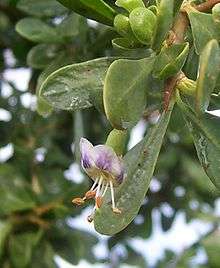Lycium ferocissimum
Lycium ferocissimum, the African boxthorn or boxthorn, is a shrub in the nightshade family (Solanaceae). The species is native to the Western Cape, Eastern Cape, and Free State provinces in South Africa and has become naturalised in Australia and New Zealand.[1] It is listed in Australia's Weed of National Significance list and is a declared noxious weed in the United States.[1][2]
| African boxthorn | |
|---|---|
 | |
| Scientific classification | |
| Kingdom: | Plantae |
| Clade: | Tracheophytes |
| Clade: | Angiosperms |
| Clade: | Eudicots |
| Clade: | Asterids |
| Order: | Solanales |
| Family: | Solanaceae |
| Genus: | Lycium |
| Species: | L. ferocissimum |
| Binomial name | |
| Lycium ferocissimum | |
Description
African boxthorn is a large shrub which grows up to 5 metres (16 ft) high and is covered in spines.
The leaves are oval in shape and are 10–40 millimetres (0.39–1.57 in) long and 4–10 millimetres (0.16–0.39 in) in width.
The solitary flowers emerge from the leaf axils and are purplish.
The species was first formally described in 1854 by British botanist John Miers in the Annals and Magazine of Natural History. His description was based on plant material collected from Uitenhage in South Africa.[3]
Lycium ferocissimum in Cyprus
 Lycium ferocissimum Fruit in Cyprus
Lycium ferocissimum Fruit in Cyprus Lycium ferocissimum Cyprus fruit inside view
Lycium ferocissimum Cyprus fruit inside view Lycium ferocissimum Flower in Cyprus
Lycium ferocissimum Flower in Cyprus
References
- "Lycium ferocissimum". Germplasm Resources Information Network (GRIN). Agricultural Research Service (ARS), United States Department of Agriculture (USDA). Retrieved 28 January 2008.
- "Noxious Weed List for Australian States and Territories" (PDF). Australian Weeds Committee. Archived from the original (PDF) on 30 August 2007. Retrieved 28 January 2008.
- "Lycium ferocissimum". Australian Plant Name Index (APNI), IBIS database. Centre for Plant Biodiversity Research, Australian Government, Canberra. Retrieved 2 August 2011.